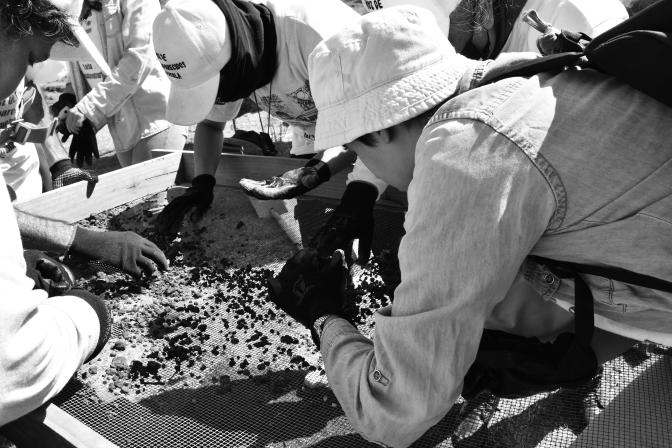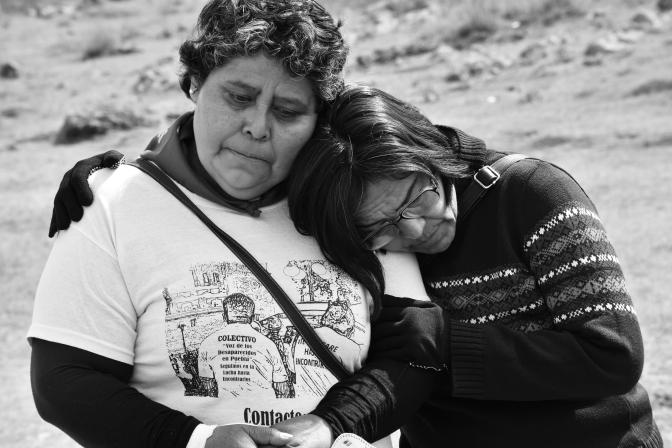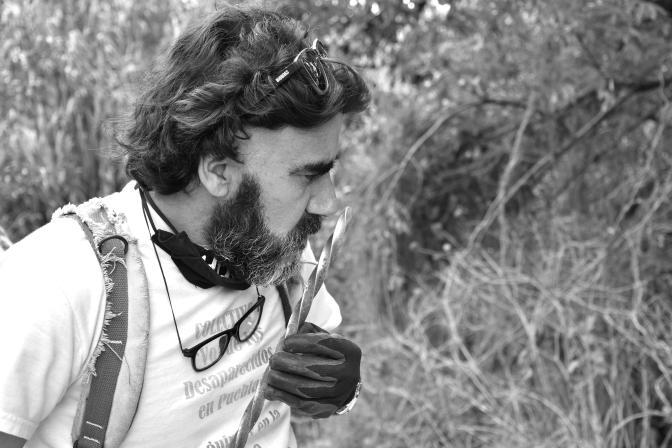They’re called los desaparecidos: the disappeared. People who left home one day and never returned. There are slightly more than a hundred thousand of them in Mexico and close to two thousand just in the state of Puebla. They may have been taken by gangs, cartels, or by the Mexican police. No one is sure why a person disappears, only that he or she is gone.
The criminals “do not ask for money or anything,” said Marcelo Salvador Salinas Cubillos, whose wife and brother-in-law disappeared three years ago. “It is not like a kidnapping. Maybe they say to someone ‘Sell drugs’ and they do not. So they disappear them. Or someone is selling drugs but not enough. So they disappear them. Or maybe there is no reason. They do it because they can.”
Cubillos is a member of the collective Voz de los Desaparecidos en Puebla, one of many such groups in Mexico that search for the desaparecidos. This collective was started in August 2018 by María Luisa Núñez Barojas, whose son, Juan De Dios Barojas, disappeared with two of his friends on April 28, 2017. Barojas lives in Tehuixtla, an area of Puebla City so dangerous that its residents don’t go out at night. “We imposed a curfew,” she said. “After six in the evening, nobody leaves their house.” But the young men were still out after dark on that day in April. “That was enough to make him a victim.”
In November 2017, after years of intense pressure from families of the desaparecidos and others, the Mexican government enacted the Ley General en Materia de Desaparición (General Law on Disappearance) and created the Comisión Nacional de Búsqueda (CNB, The National Commission for Searches), which is tasked with finding missing persons. In addition to the national CNB, there are CNBs in every state. Barojas said they received no help from the CNB-Puebla, so she started looking online for information and assistance. That’s where she found out about the collectives that searched for desaparecidos in other states.
She was initially reluctant to join a collective or start one in Puebla. “I saw that the collectives were looking primarily in clandestine graves and I did not want to think that my son was dead,” she said. “I saw that collectives made protest marches. I said, ‘I am not going to find my son by marching.’” But in August of 2018, frustrated with the lack of help from the government, she decided to start Voz de los Desaparecidos en Puebla to help families find those who had disappeared.

Members of the collective search hospitals, psychiatric hospitals, prisons, and the streets, hoping to find desaparecidos who are still alive. But they also conduct searches for bodies a few times a month. Cubillos, who joined the collective a little more than two years ago, said someone in the group may get a phone call that tells them that “in a certain place there is a clandestine grave or in such a place they throw bodies.” In July, the collective searched for Rosabella Sánchez Juárez’s son, Rodrigo.
Rodrigo was studying for his bachelor’s degree and had a job servicing pools. He left his home in San Sebastián El Seco, Puebla, on October 26, 2020, between 6:30 and 7:00 in the evening. When he didn’t return home that night, his mother and his wife began sending him texts. “He never answered,” Juárez said. “It was dawn and we did not know what happened. We could not say if the police took him or some other person.” Rodrigo never returned. Juárez told me that although she’s not sure who was responsible, she has her suspicions. “There are people who know but they do not say anything. Unfortunately, people are afraid and they do not talk about crime. For me, I lived in my bubble inside my home and did not have problems. But the bubble broke. They broke the bubble and I had to leave [home] and start investigating.” For two days in July 2022, members of Voz de los Desaparecidos en Puebla searched for Rodrigo’s body.
About twenty members of the collective drove to a large field in El Seco late in the morning of July 25, the first day of a two-day search. The field contained several deep, abandoned wells. The collective chose this area to search because, Barojas told me, “someone smelled decomposition and saw lime.” Lime is used to cover bodies. Barojas added that “wells are places where criminals often dump bodies.” They were accompanied by firemen, who would be lowered into the well, and five soldiers from the National Guard, who would provide protection. Several members of the collective have received threats. Since the beginning of 2021, at least five mothers who were searching for missing family members have been murdered in Mexico.
Before the search began, Juárez handed each person a small yellow pílodora de éter (ether pill). “People here have the belief that a culture of witchcraft exists and there is mal aire,” she said. Literally, mal aire just means “bad air,” but in this context aire refers to spirits and mal aire to evil spirits. “There is the belief that pílodora de éter keeps evil spirits and evil people away.” Barojas took me aside. “Do not take photographs of their faces,” she said, referring to the firemen and National Guard. “It is to keep them and their families safe. Criminals will look at social media and recognize faces.” She also told me to use only the first names of the people I interviewed unless they gave me permission to use their full names.
Members of the collective know that they, too, are at risk. “Fear forms part of the searches,” said Miguel Ángel Martínez Martínez. “There is fear, yes. There is uncertainty. But maybe I wouldn’t call it fear because fear paralyzes.” Martínez has been volunteering with the collective for three years, though none of his own family are among the desaparecidos. When I asked him why he does it, he immediately replied, “Why not? To me, it is a scandal.” Later he added, “You have to be a little crazy to do this. You do not look with your mind, but with your heart.”

As a fireman was lowered into a well, Juárez stood and stared, her eyes filling with tears. Barojas put her arms around her, consoling her. She knows the agony of losing a child and then finding his body. The collective found her son in November 2020. “They tortured him horribly,” she told me. “They executed him, they threw him in a grave more than twenty meters deep. It hurts so much.” She paused. “He is finally safe from so much evil. The torture of not knowing how he is doing is over.”
Members of the collective talked and joked as they gathered for the search but fell silent as the first bag of dirt was brought up from the well and its contents dumped on a screen. The atmosphere was tense, a mix of hope and dread, as people knelt and sifted through the dirt, finding only bones of mice and some other animals. Later in the afternoon, Gregorio (not his real name), a member of the CNB-Puebla, led a group into the field to search for graves.
“You have to think like a criminal,” he said. “‘Where will I leave him? Do I want to carry a body up that hill? Where can I hide a body?’” He and Cubillos, who has been on many searches, looked for unevenness on the ground. “There may be a depression,” Cubillos said. “The shape is usually round but sometimes square. If the grave is fresh, there is usually a mound but after a rain, the ground sinks a bit.” Gregorio also looks for spots where the vegetation is different. “A buried body serves as fertilizer,” he said. “The vegetation is greener.”

Gregorio swept the ground with a metal detector and when it pinged or when he noticed a depression, he sunk a thin metal pole called a varilla into the ground. “If the varilla goes in easy,” he said, “there may be a grave.” Sometimes, when a hole is drilled, a smell of decomposition is released. “The smell of a human is very characteristic,” he explained. “It is not the smell of a dog or a cat.” Cubillos will also sniff the tip of the varilla to detect decomposition.
After locating what he thought might be a grave, he drew a twenty-by-twenty-centimeter square in the dirt and began to dig. He found some clothing, but no bodies. If a body is found, the digging stops. “When we find a body, we call in an anthropologist, an archeologist, and a criminalist,” said Cubillos. “We do not touch or move the body. Sometimes it can be identified by clothing or a tattoo. Sometimes DNA is used to identify it.”
No bodies were found during the two days of the search for Juárez’s son. “This week, I did not sleep,” she said. “I want to find him but not this way. I am glad we did not find anyone but sad we did not find anyone. It is a mix of emotions. I do not think that a criminal has a heart. To kill someone and carry them here…”
Many families of the desaparecidos don’t conduct searches or investigations because they’re afraid that those responsible for the disappearance of their loved ones may come after them. Those fears aren’t unwarranted. Just how dangerous searching can be was tragically demonstrated last October, when Blanca Esmeralda Gallardo, a member of the Puebla collective, was investigating the disappearance of her daughter, who’d been missing since January 13, 2021. Although she’d received death threats several times, she continued her search. Gallardo was on her way to work before dawn on October 4 when a group of gunmen shot and killed her. Barojas is convinced it was the same people who had taken Gallardo’s daughter. “Of course it was,” Barojas said. “They know she had identified them. They wanted to eliminate the risk. As far as we know, she did not have any other affair or problem that would put her at risk.” I asked Borojas for more details about Gallardo’s life, but she couldn’t—or wouldn’t—provide any. “It is important that you know in the collective, we do not get involved in a person’s life,” she said. “Only up to what they permit. This is for safety.” When I asked for permission to use a photo I took of Gallardo, her son, and her granddaughter at an event in Puebla, Borojas asked me to blur the faces of the two children.
Borojas told me that her group would continue searching for the desaparecidos, despite the killing of one of its members. “We will continue the struggle,” she said. “We are redoubling security measures within the collective.” Members of the collective believe that it’s still important to search for people who have been missing for years. “It is to have the certainty that you can bring them here to the pueblo and leave them in holy ground,” said Cubillos. “To let them rest in peace [so] that they are not in the underworld or in limbo. Because I believe that anyone who is missing wants to be found. We do not want revenge, only justice and, more than anything, to find our families.”
My last interview with Juárez took place in a small room in the house that she’d recently moved into. She has moved five times since her son disappeared. “People here are afraid. People found out my situation and they said, ‘We do not want problems. Please move.’ People really do not have empathy.” Juárez had a series of low-paying jobs, including cleaning homes, but she no longer works. “Now that I am searching for my son, I do not work so I can dedicate myself to that,” she told me. “My son, he sustained us. Our family has crumbled. When he disappeared, my son was twenty-six. Now he is twenty-eight.” She still speaks about him in the present tense. “I believe now that they have already left me dead while alive. Yes, I have my daughter and granddaughters but I am missing another part. I am a single mother and for me, he was my man. They killed me. I am not afraid. They took what was my strength.”
Her son Rodrigo’s daughter is now four years old and troubled by his absence. “For her, he was everything. She always asks, ‘Where is daddy?’ and we tell her he is working, that he had to work far away and because of this he cannot come home. We have problems with her in school; she does not want to participate. His daughter needs to know where her father is. At minimum, if we find him dead, at least she can take him a flower. Because then we can cry. We look for him and I do not know what happened to him. We do not know if he is still alive, if he has something to eat, or, if they have killed him, where they left him.”
I interviewed Juárez on the second anniversary of her son’s disappearance. I asked her if she was going to do anything special to mark the day. She told me no. “I just want to remember what we talked about and what we did together, to keep him with me. I do not have anything more of him, nothing more than his memory. I have nothing more than those memories.”
And so she and members of the Voz de los Desaparecidos en Puebla and other collectives across Mexico continue their search. The CNB website lists 103,261 desaparecidos in Mexico and 1,816 in Puebla. But since many families are afraid the people who took their relatives could come after them, they don’t always report disappearances. That means there are many more lying buried somewhere. “The whole country is a clandestine grave,” said Cubillos. “The whole country.”
Please email comments to [email protected] and join the conversation on our Facebook page.
Share
Previous Story
Alone in the City
Next Story
Religious Seekers, or Cultural Thieves?